engine overheat TOYOTA LAND CRUISER 1999 Owners Manual
[x] Cancel search | Manufacturer: TOYOTA, Model Year: 1999, Model line: LAND CRUISER, Model: TOYOTA LAND CRUISER 1999Pages: 202, PDF Size: 1.92 MB
Page 84 of 202
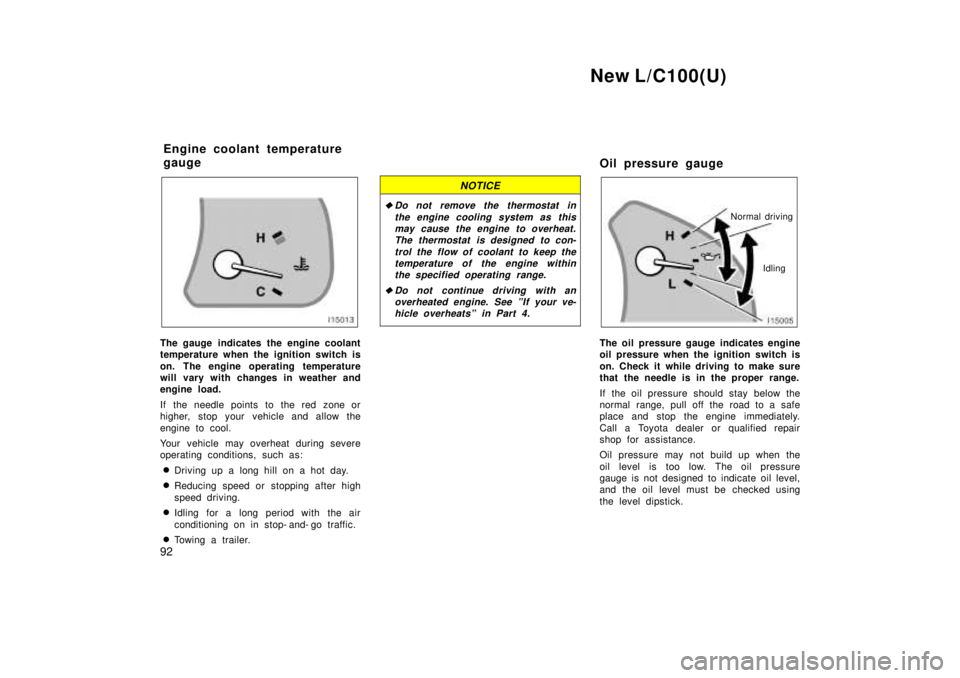
New L/C100(U)
92
The gauge indicates the engine coolant
temperature when the ignition switch is
on. The engine operating temperature
will vary with changes in weather and
engine load.
If the needle points to the red zone or
higher, stop your vehicle and allow the
engine to cool.
Your vehicle may overheat during severe
operating conditions, such as: � Driving up a long hill on a hot day.
� Reducing speed or stopping after high
speed driving.
� Idling for a long period with the air
conditioning on in stop- and- go traffic.
� Towing a trailer.
NOTICE
�Do not remove the thermostat in
the engine cooling system as thismay cause the engine to overheat.The thermostat is designed to con-
trol the flow of coolant to keep thetemperature of the engine withinthe specified operating range.
�Do not continue driving with anoverheated engine. See ºIf your ve-hicle overheatsº in Part 4.
Oil pressure gauge
Idling
Normal driving
The oil pressure gauge indicates engine
oil pressure when the ignition switch is
on. Check it while driving to make sure
that the needle is in the proper range.
If the oil pressure should stay below the
normal range, pull off the road to a safe
place and stop the engine immediately.
Call a Toyota dealer or qualified repair
shop for assistance.
Oil pressure may not build up when the
oil level is too low. The oil pressure
gauge is not designed to indicate oil level,
and the oil level must be checked using
the level dipstick.
Engine coolant temperature
gauge
Page 94 of 202
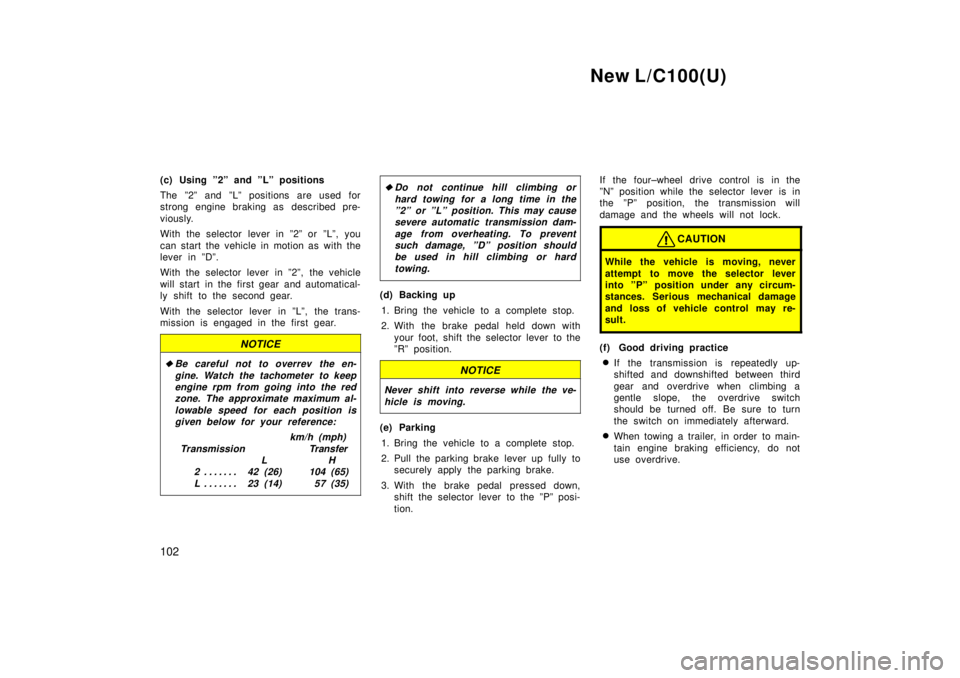
New L/C100(U)
102
(c) Using º2º and ºLº positions
The º2º and ºLº positions are used for
strong engine braking as described pre-
viously.
With the selector lever in º2º or ºLº, you
can start the vehicle in motion as with the
lever in ºDº.
With the selector lever in º2º, the vehicle
will start in the first gear and automatical-
ly shift to the second gear.
With the selector lever in ºLº, the trans-
mission is engaged in the first gear.
NOTICE
�Be careful not to overrev the en-
gine. Watch the tachometer to keepengine rpm from going into the red zone. The approximate maximum al-
lowable speed for each position isgiven below for your reference:
km/h (mph)
Transmission Transfer L H
2 42 (26) 104 (65) . . . . . . .
L 23 (14) 57 (35) . . . . . . .
�Do not continue hill climbing or
hard towing for a long time in theº2º or ºLº position. This may causesevere automatic transmission dam-
age from overheating. To preventsuch damage, ºDº position shouldbe used in hill climbing or hard
towing.
(d) Backing up
1. Bring the vehicle to a complete stop.
2. With the brake pedal held down with your foot, shift the selector lever to the
ºRº position.
NOTICE
Never shift into reverse while the ve-
hicle is moving.
(e) Parking
1. Bring the vehicle to a complete stop.
2. Pull the parking brake lever up fully to securely apply the parking brake.
3. With the brake pedal pressed down, shift the selector lever to the ºPº posi-
tion. If the four±wheel drive control is in the
ºNº position while the selector lever is in
the ºPº position, the transmission will
damage and the wheels will not lock.
CAUTION
While the vehicle is moving, never
attempt to move the selector lever
into ºPº position under any circum-
stances. Serious mechanical damage
and loss of vehicle control may re-
sult.
(f) Good driving practice
� If the transmission is repeatedly up-
shifted and downshifted between third
gear and overdrive when climbing a
gentle slope, the overdrive switch
should be turned off. Be sure to turn
the switch on immediately afterward.
� When towing a trailer, in order to main-
tain engine braking efficiency, do not
use overdrive.
Page 147 of 202
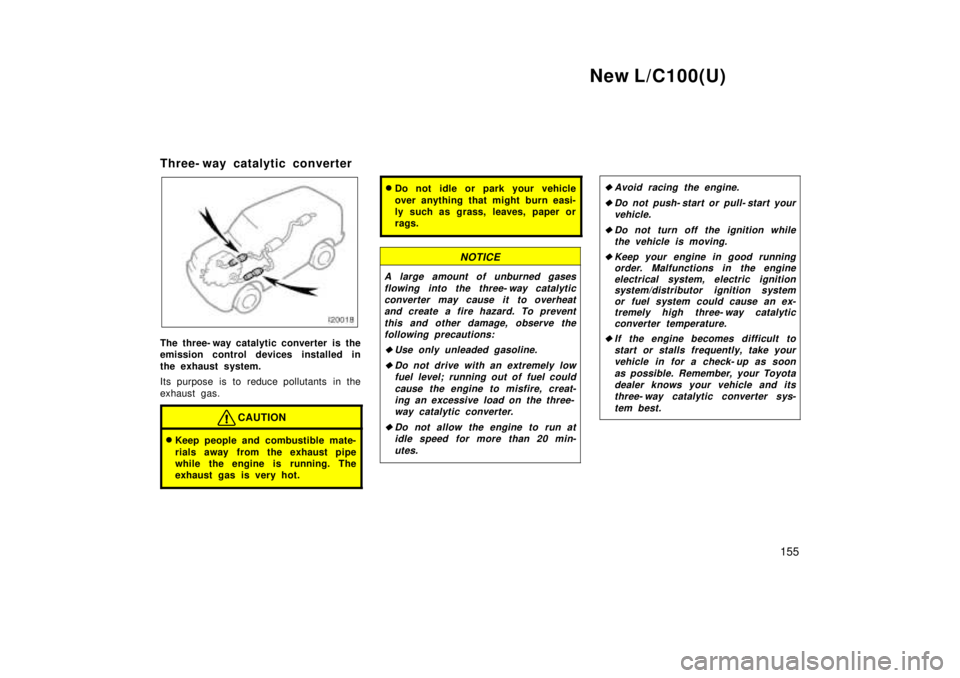
New L/C100(U)155
Three- way catalytic converter
The three- way catalytic converter is the
emission control devices installed in
the exhaust system.
Its purpose is to reduce pollutants in the
exhaust gas.
CAUTION
�
Keep people and combustible mate-
rials away from the exhaust pipe
while the engine is running. The
exhaust gas is very hot.
�Do not idle or park your vehicle
over anything that might burn easi-
ly such as grass, leaves, paper or
rags.
NOTICE
A large amount of unburned gases
flowing into the three- way catalyticconverter may cause it to overheat and create a fire hazard. To prevent
this and other damage, observe thefollowing precautions:
�Use only unleaded gasoline.
�Do not drive with an extremely lowfuel level; running out of fuel could
cause the engine to misfire, creat-ing an excessive load on the three- way catalytic converter.
�Do not allow the engine to run atidle speed for more than 20 min-
utes.
�Avoid racing the engine.
�Do not push- start or pull- start yourvehicle.
�Do not turn off the ignition whilethe vehicle is moving.
�Keep your engine in good runningorder. Malfunctions in the engine
electrical system, electric ignitionsystem/distributor ignition system
or fuel system could cause an ex-tremely high three- way catalytic
converter temperature.
�If the engine becomes difficult to
start or stalls frequently, take yourvehicle in for a check- up as soon
as possible. Remember, your Toyotadealer knows your vehicle and itsthree- way catalytic converter sys-
tem best.
Page 160 of 202

New L/C100(U)
168
(b) Starting the engine
Before starting the engine, be sure to fol-
low the instructions in º(a) Before crank-
ingº.
Normal starting procedure
The multiport fuel injection system/sequen-
tial multiport fuel injection system in your
engine automatically controls the proper
air- fuel mixture for starting. You can start
a cold or hot engine as follows:
1. With your foot off the accelerator ped- al, crank the engine by turning the key
to ºSTARTº. Release it when the en-
gine starts.
2. After the engine runs for about 10 se- conds, you are ready to drive.
If the weather is below freezing, let the
engine warm up for a few minutes be-
fore driving.
If the engine stalls...
Simply restart it, using the correct proce-
dure given in normal starting.
If the engine will not start...
See ºIf your vehicle will not startº in Part 4.
NOTICE
�Do not crank for more than 30 se- conds at a time. This may overheatthe starter and wiring systems.
�Do not race a cold engine.
�If the engine becomes difficult tostart or stalls frequently, have the
engine checked immediately.
� Always slow down in gusty crosswinds.
This will allow you much better control.
� Drive slowly onto curbs and, if pos-
sible, at a right angle. Avoid driving
onto high, sharp- edged objects and
other road hazards. Failure to do so
can lead to severe tire damage result-
ing in tire bursts.
� When parking on a hill, turn the front
wheels until they touch the curb so
that the vehicle will not roll. Apply the
parking brake, and place the transmis-
sion in ºPº. If necessary, block the
wheels.
� Washing your vehicle or driving through
deep water may get the brakes wet. To
see whether they are wet, check that
there is no traffic near you, and then
press the pedal lightly. If you do not
feel a normal braking force, the brakes
are probably wet. To dry them, drive
the vehicle cautiously while lightly
pressing the brake pedal with the park-
ing brake pulled. If they still do not
work safely, pull to the side of the road
and call a Toyota dealer for assistance.
Tips for driving
in various conditions
Page 161 of 202
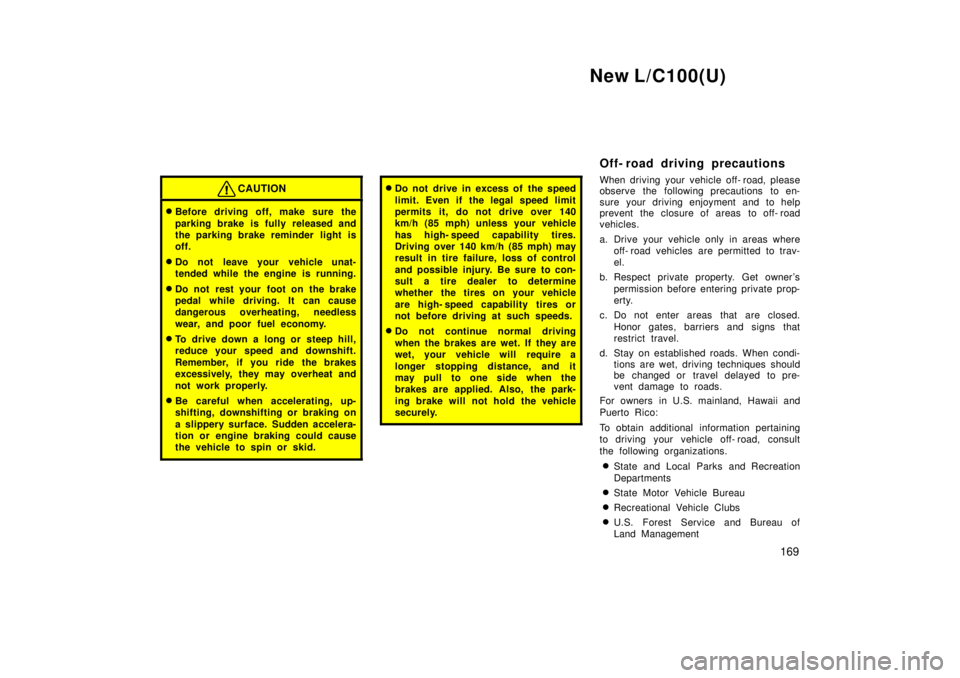
New L/C100(U)169
CAUTION
�Before driving off, make sure the
parking brake is fully released and
the parking brake reminder light is
off.
� Do not leave your vehicle unat-
tended while the engine is running.
� Do not rest your foot on the brake
pedal while driving. It can cause
dangerous overheating, needless
wear, and poor fuel economy.
� To drive down a long or steep hill,
reduce your speed and downshift.
Remember, if you ride the brakes
excessively, they may overheat and
not work properly.
� Be careful when accelerating, up-
shifting, downshifting or braking on
a slippery surface. Sudden accelera-
tion or engine braking could cause
the vehicle to spin or skid.
�Do not drive in excess of the speed
limit. Even if the legal speed limit
permits it, do not drive over 140
km/h (85 mph) unless your vehicle
has high- speed capability tires.
Driving over 140 km/h (85 mph) may
result in tire failure, loss of control
and possible injury. Be sure to con-
sult a tire dealer to determine
whether the tires on your vehicle
are high- speed capability tires or
not before driving at such speeds.
� Do not continue normal driving
when the brakes are wet. If they are
wet, your vehicle will require a
longer stopping distance, and it
may pull to one side when the
brakes are applied. Also, the park-
ing brake will not hold the vehicle
securely.
Off- road driving precautions
When driving your vehicle off- road, please
observe the following precautions to en-
sure your driving enjoyment and to help
prevent the closure of areas to off- road
vehicles.
a. Drive your vehicle only in areas where
off- road vehicles are permitted to trav-
el.
b. Respect private property. Get owner 's permission before entering private prop-
erty.
c. Do not enter areas that are closed. Honor gates, barriers and signs that
restrict travel.
d. Stay on established roads. When condi- tions are wet, driving techniques should
be changed or travel delayed to pre-
vent damage to roads.
For owners in U.S. mainland, Hawaii and
Puerto Rico:
To obtain additional information pertaining
to driving your vehicle off- road, consult
the following organizations.
� State and Local Parks and Recreation
Departments
� State Motor Vehicle Bureau
� Recreational Vehicle Clubs
� U.S. Forest Service and Bureau of
Land Management
Page 169 of 202

New L/C100(U)177
�
Avoid jerky starts or sudden accelera-
tion.
� Avoid jerky steering and sharp turns.
The trailer could hit your vehicle in a
tight turn. Slow down before making a
turn to avoid the necessity of sudden
braking.
� Remember that when making a turn,
the trailer wheels will be closer than
the vehicle wheels to the inside of the
turn. Therefore, compensate for this by
making a larger than normal turning
radius with your vehicle.
� Backing with a trailer is difficult and
requires practice. Grip the bottom of
the steering wheel and move your hand
to the left to move the trailer to the
left. Move your hand to the right to
move the trailer to the right. (This pro-
cedure is generally opposite to that
when backing without a trailer). Also,
just turn the steering wheel a little at
a time, avoiding sharp or prolonged
turning. Have someone guide you when
backing to reduce the risk of an acci-
dent. �
Crosswinds and rough roads will ad-
versely affect handling of your vehicle
and trailer, causing sway. Pay attention
to the rear from time to time to pre-
pare yourself for being passed by large
trucks or buses, which may cause your
vehicle and trailer to sway. If swaying
happens, firmly grip the steering wheel
and reduce speed immediately but
gradually. Never increase speed. Steer
straight ahead. If you make no extreme
correction with the steering or brakes,
the vehicle and trailer will stabilize it-
self.
� Be careful when passing other ve-
hicles. Passing requires considerable
distance. After passing a vehicle, do
not forget the length of your trailer and
be sure you have plenty of room be-
fore changing lanes.
� In order to maintain engine braking effi-
ciency, do not use the ºDº position. �
Because of the added load of the trail-
er, your vehicle's engine may overheat
on hot days (at temperatures over 305C [85 5F]) when going up a long or
steep grade with a trailer. If the engine
coolant temperature gauge indicates
overheating, immediately turn off the air
conditioning (if in use), pull off the road
and stop in a safe spot. Refer to ºIf
your vehicle overheatsº in Part 4 of
this manual.
� Always place wheel blocks under both
the vehicle and trailer wheels when
parking. Apply the parking brake firmly.
Put the transmission in ºPº. Avoid park-
ing on a slope with a trailer, but if it
cannot be avoided, do so only after
performing the following:
1. Apply the brakes and hold.
2. Have someone place wheel blocks under both the vehicle and trailer
wheels.
3. When the wheel blocks are in place, release your brakes slowly until the
blocks absorb the load.
4. Apply the parking brake firmly.
5. Shift into ºPº and turn off the en- gine.
Page 170 of 202
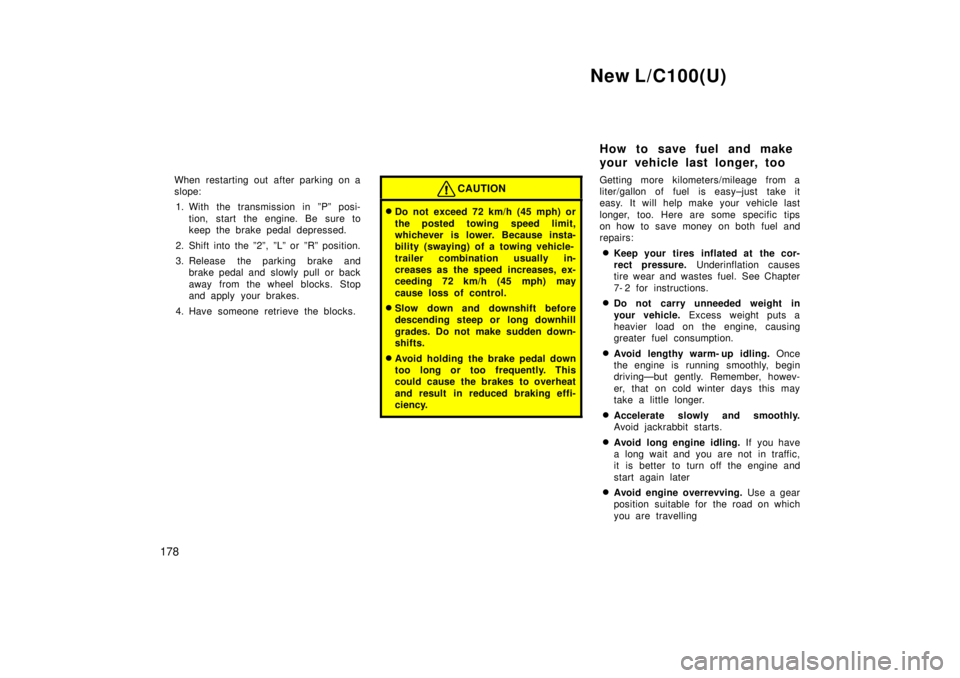
New L/C100(U)
178 When restarting out after parking on a
slope:
1. With the transmission in ºPº posi- tion, start the engine. Be sure to
keep the brake pedal depressed.
2. Shift into the º2º, ºLº or ºRº position.
3. Release the parking brake and brake pedal and slowly pull or back
away from the wheel blo cks. Stop
and apply your brakes.
4. Have someone retrieve the blo cks.
CAUTION
�Do not exceed 72 km/h (45 mph) or
the posted towing speed limit,
whichever is lower. Because insta-
bility (swaying) of a towing vehicle-
trailer combination usually in-
creases as the speed increases, ex-
ceeding 72 km/h (45 mph) may
cause loss of control.
� Slow down and downshift before
descending steep or long downhill
grades. Do not make sudden down-
shifts.
� Avoid holding the brake pedal down
too long or too frequently. This
could cause the brakes to overheat
and result in reduced braking effi-
ciency.
Getting more kilometers/mileage from a
liter/gallon of fuel is easy±just take it
easy. It will help make your vehicle last
longer, too. Here are some specific tips
on how to save money on both fuel and
repairs:
� Keep your tires inflated at the cor-
rect pressure. Underinflation causes
tire wear and wastes fuel. See Chapter
7- 2 for instructions.
� Do not carry unneeded weight in
your vehicle. Excess weight puts a
heavier load on the engine, causing
greater fuel consumption.
� Avoid lengthy warm- up idling. Once
the engine is running smoothly, begin
drivingÐbut gently. Remember, howev-
er, that on cold winter days this may
take a little longer.
� Accelerate slowly and smoothly.
Avoid jackrabbit starts.
� Avoid long engine idling. If you have
a long wait and you are not in traffic,
it is better to turn off the engine and
start again later
� Avoid engine overrevving. Use a gear
position suitable for the road on which
you are travelling
How to save fuel and make
your vehicle last longer, too
Page 171 of 202
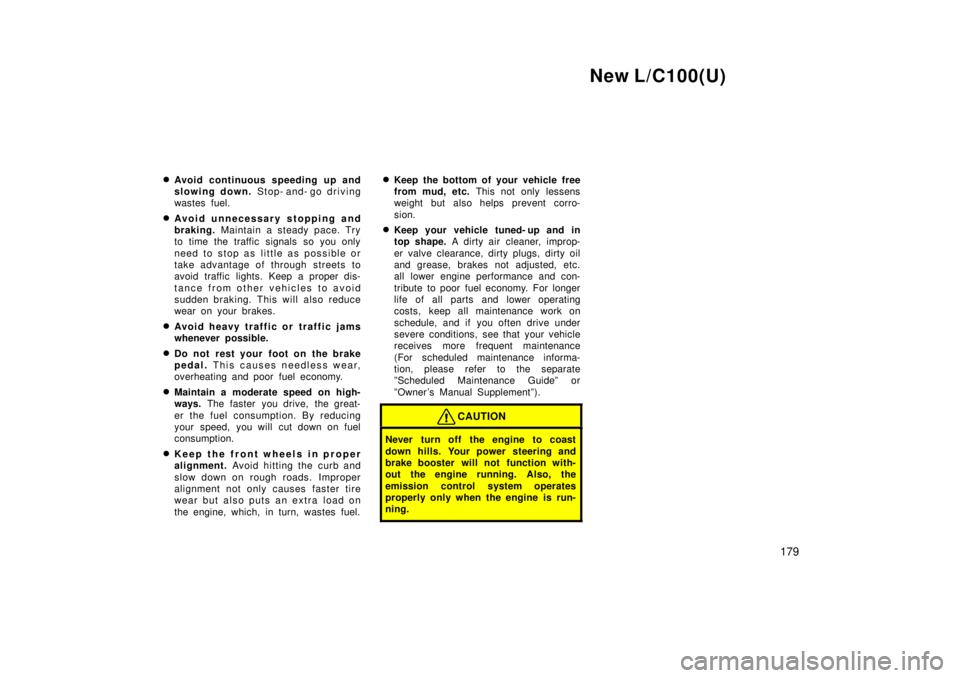
New L/C100(U)179
�
Avoid continuous speeding up and
slowing down. Stop- and- go driving
wastes fuel.
� Avoid unnecessary stopping and
braking. Maintain a steady pace. Try
to time the traffic signals so you only
need to stop as little as possible or
take advantage of through streets to
avoid traffic lights. Keep a proper dis-
tance from other vehicles to avoid
sudden braking. This will also reduce
wear on your brakes.
� Avoid heavy traffic or traffic jams
whenever possible.
� Do not rest your foot on the brake
pedal. This causes needless wear,
overheating and poor fuel economy.
� Maintain a moderate speed on high-ways. The faster you drive, the great-
er the fuel consumption. By reducing
your speed, you will cut down on fuel
consumption.
� Keep the front wheels in proper
alignment. Avoid hitting the curb and
slow down on rough roads. Improper
alignment not only causes faster tire
wear but also puts an extra load on
the engine, which, in turn, wastes fuel. �
Keep the bottom of your vehicle free
from mud, etc. This not only lessens
weight but also helps prevent corro-
sion.
� Keep your vehicle tuned- up and in
top shape. A dirty air cleaner, improp-
er valve clearance, dirty plugs, dirty oil
and grease, brakes not adjusted, etc.
all lower engine performance and con-
tribute to poor fuel economy. For longer
life of all parts and lower operating
costs, keep all maintenance work on
schedule, and if you often drive under
severe conditions, see that your vehicle
receives more frequent maintenance
(For scheduled maintenance informa-
tion, please refer to the separate
ºScheduled Maintenance Guideº or
ºOwner 's Manual Supplementº).
CAUTION
Never turn off the engine to coast
down hills. Your power steering and
brake booster will not function with-
out the engine running. Also, the
emission control system operates
properly only when the engine is run-
ning.
Page 202 of 202

New L/C100(U)Publication No. OM60811U
Part No. 01999-60811
Printed in Japan 01- 9810- 00
(U)
Quick index
� If a service reminder indicator or warning buzzer comes on 94 . . . . .
� If your vehicle will not start 181
. . . . . . . . . . . . . . . . . . . . . . . . . . . . . . . . . . .
� If your engine stalls while driving 185 . . . . . . . . . . . . . . . . . . . . . . . . . . . . . .
� If your vehicle overheats 185
. . . . . . . . . . . . . . . . . . . . . . . . . . . . . . . . . . . . . .
� If you have a flat tire 186
. . . . . . . . . . . . . . . . . . . . . . . . . . . . . . . . . . . . . . . . .
� If your vehicle needs to be towed 195 . . . . . . . . . . . . . . . . . . . . . . . . . . . . .
� Tips for driving during break-in period 152 . . . . . . . . . . . . . . . . . . . . . . . . . .
� How to start the engine 167
. . . . . . . . . . . . . . . . . . . . . . . . . . . . . . . . . . . . . . .
� General maintenance 208
. . . . . . . . . . . . . . . . . . . . . . . . . . . . . . . . . . . . . . . . . .
� Complete index NO TAG
. . . . . . . . . . . . . . . . . . . . . . . . . . . . . . . . . . . . . . . . . .
Gas station information
Fuel type: Premium UNLEADED gasoline, Octane Rating 91 (Research Octane
Number 96) or higher for optimum engine performance However, if
such premium type cannot be obtained, you may temporarily use
unleaded gasoline with an Octane Rating as low as 87 (Research
Octane Number 91).
See page 153 for detailed information.
Fuel tank capacity: 96 L (25.4 gal., 21.1 lmp. gal.)
Engine oil:
API grade SJ, ºEnergy- Conservingº multigrade engine oil or ILSAC
multigrade engine oil is recommended.
See page 220 for detailed information.
Automatic transmission fluid: Automatic transmission fluid D- II or DEXRON �
III (DEXRON �
II)
Tire information: See pages 224 through 228.
Tire pressure: See page 244.
U�3
I